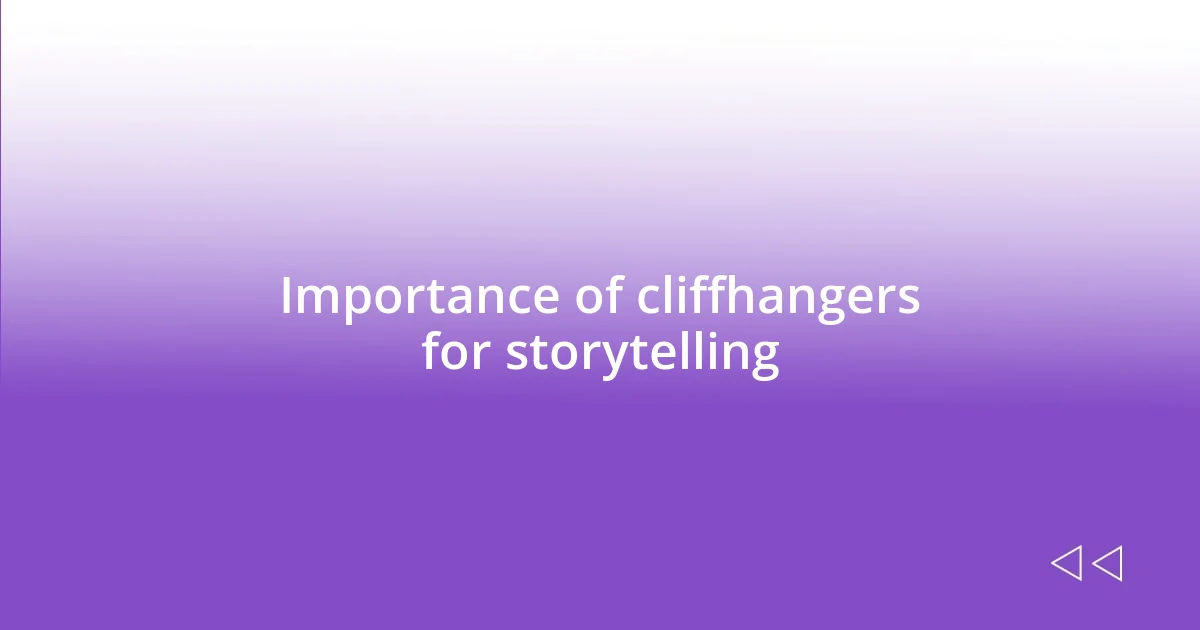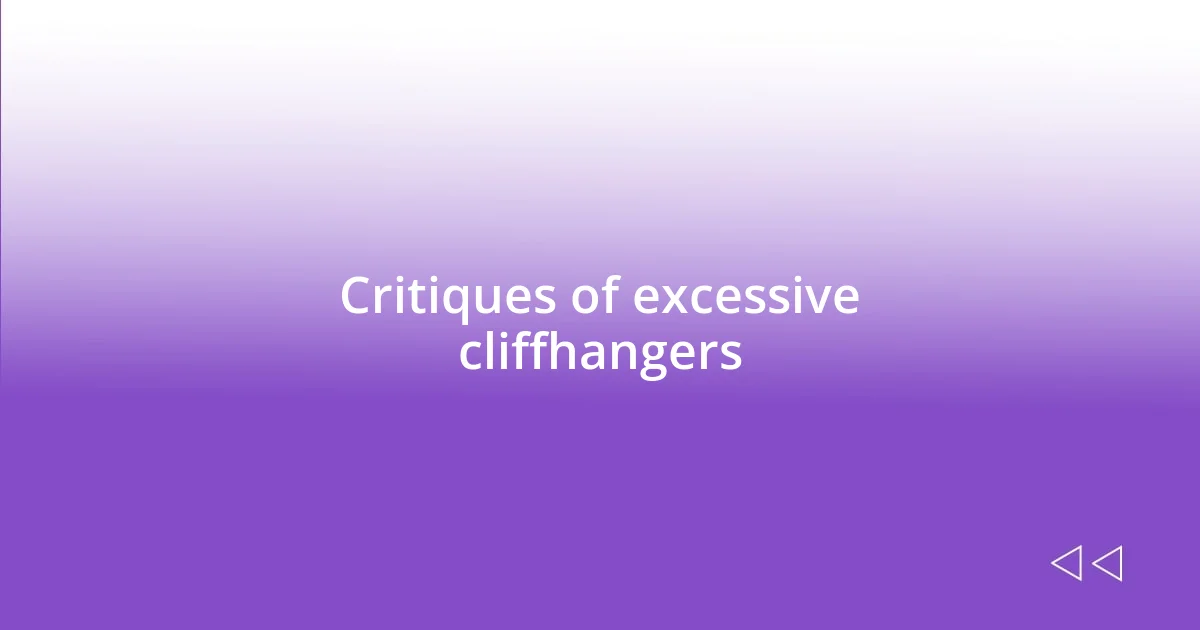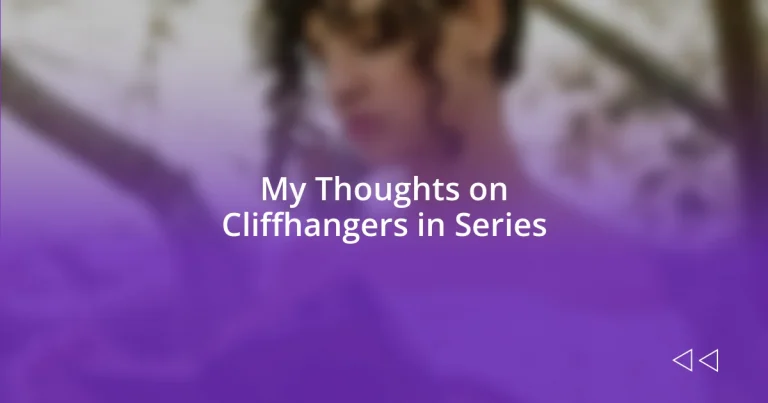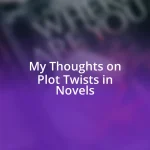Key takeaways:
- Cliffhangers enhance emotional investment and engagement, driving viewer discussions and encouraging binge-watching.
- Different types of cliffhangers—dramatic, character-focused, and plot-driven—serve distinct storytelling purposes and evoke varied emotional responses.
- Effective cliffhangers should balance suspense with plot development to maintain character growth and viewer interest, avoiding excessive reliance that can frustrate audiences.

Understanding cliffhangers in series
Cliffhangers serve as a powerful storytelling device, intentionally leaving audiences on the edge of their seats. I remember binge-watching a series with my friends, and when the screen faded to black after a shocking revelation, our reactions were a mix of disbelief and excitement. Why do we crave that feeling of suspense, of not knowing what comes next?
At their core, cliffhangers are designed to provoke an emotional response, compelling viewers to return and unravel the mystery. I’ve often found myself discussing potential plot twists with friends for hours after a season finale. Isn’t it fascinating how a simple unresolved moment can lead to endless theories and debates?
These moments enhance engagement, creating a bond between the audience and the narrative. Have you ever found yourself glued to a series because you simply couldn’t bear to leave a story incomplete? I certainly have; there’s an undeniable thrill in the uncertainty, a rush that keeps us connected to the unfolding tale.

Importance of cliffhangers for storytelling
Cliffhangers hold a crucial place in storytelling, acting as a bridge between episodes or chapters that can dramatically alter our experience. I recall one late-night binge where a cliffhanger prompted me to jump out of bed and replay the last scene to grasp each detail. That pulse of adrenaline—wondering what would happen next—genuinely made the storytelling feel alive. It’s that thrill of the unknown that keeps us invested.
- They create emotional investment: We become attached to characters when we’re left wondering about their fate.
- They drive discussions: Shared theories and reactions among friends enhance the viewing experience and create a community around the story.
- They encourage binge-watching: One episode ends, and the cliffhanger often demands that we dive straight into the next.
- They maintain narrative momentum: Cliffhangers keep the story dynamic, ensuring that the plot continuously evolves.
When crafted skillfully, these unresolved moments transform a simple story into an exhilarating journey—one that lingers in our minds long after the credits roll. It amazes me how a few carefully placed words or images can evoke such powerful anticipation.

Types of cliffhangers in series
Cliffhangers are not one-size-fits-all; they come in various types that cater to different storytelling needs. One common type is the dramatic cliffhanger, typically occurring at a pivotal moment that changes everything for the characters involved. I remember watching a series where a character was almost caught in a lie right before the episode ended. The tension was palpable, and I felt my heart racing as I anticipated the fallout on the next episode. How often have you found yourself rattling off theories at the end of an episode, wondering how the story will twist next?
Another type is the character-focused cliffhanger. These often revolve around critical decisions or developments affecting a beloved character’s fate. I experienced this firsthand with a show where a main character made a life-altering choice, leaving me torn over whether it was the right decision. I found myself empathizing deeply, pondering what I would do in their shoes. Isn’t it intriguing how we can become so emotionally invested in fictional scenarios?
Last but not least, there are plot-driven cliffhangers, which leave audiences questioning the future of the entire narrative. I vividly recall the end of a season where a shocking event unfolded, creating an entirely new mystery to solve. It felt like a puzzle piece had been placed in the wrong spot, sparking discussions about potential directions for the next season. These different types not only add layers to the narrative but also demonstrate how they can evoke various emotions and knee-jerk reactions from us as viewers.
| Type of Cliffhanger | Description |
|---|---|
| Dramatic | Occurs at a pivotal moment that alters the story’s trajectory. |
| Character-Focused | Revolves around crucial decisions affecting character fates. |
| Plot-Driven | Leaves audiences questioning the future direction of the narrative. |

Balancing cliffhangers with plot development
Balancing cliffhangers with plot development is an intricate dance. If a series relies too heavily on cliffhangers, they can overshadow the core narrative, leading to frustration instead of excitement. I still remember a well-loved series that ended a thrilling episode on a shocking cliffhanger, but when the next one began, it felt like the resolution dragged on too long, dulling the thrill. Have you ever felt that spark fizzle out?
It’s essential for writers to recognize that cliffhangers should enhance the plot, not replace it. I recall an anthology series that used little cliffhangers between episodes, teasing the next story while still focusing on each episode’s unique character arc. This approach not only built suspense but also allowed the audience to feel satisfied with each story. For me, it struck the perfect balance and left me eagerly anticipating the next story while still feeling fulfilled.
The key to effective storytelling lies in understanding when to leave questions unanswered and when to reveal vital information. A series that beautifully executed this balance was a classic drama where major plot developments occurred alongside cliffhangers, enriching the overall narrative. I found myself completely invested, eagerly speculating on what the next twist could mean for the characters and their journeys. Isn’t it captivating when a show can hold both surprise and progression in tandem?

Critiques of excessive cliffhangers
Excessive cliffhangers can often frustrate viewers rather than keep them engaged. I remember getting irritated with a show that ended every episode on an unresolved tension, leaving me feeling strung along. It was like a tease without payoff, and I often questioned if the writers were just prolonging the story to keep us watching. Have you ever felt like the suspense turned into annoyance?
When cliffhangers become a series’ crutch, they risk undermining character development. There was a particular series I once adored where the relentless suspense overshadowed the growth of the characters themselves. I found myself more invested in solving the mystery than actually caring about what happened to the characters I initially loved. It raises a question—are we watching for the plot twists, or for the people we’ve grown attached to?
Moreover, relying heavily on cliffhangers can diminish their impact over time. In one series I followed, the continuous cycle of suspense became predictable. By the time a major twist happened, I was left feeling indifferent rather than excited. It made me wonder if the thrill of the unknown can ever truly remain effective if it’s pushed too far. Isn’t it the heart in storytelling that keeps us coming back?

Best practices for using cliffhangers
Creating effective cliffhangers is an art that requires finesse. I’ve found that the best cliffhangers leave viewers craving more by focusing not just on shock value but on emotional stakes. For example, when a character is faced with a hard decision, cutting to black right before they choose can evoke a sense of urgency and investment. Don’t you feel that anticipation in those moments?
Timing is everything. I remember watching a series that ended a season with a cliffhanger that felt perfectly timed—not too abrupt but just enough to leave me hanging. It made me think: how can writers gauge the right moment to strike? By building up to that moment, the creators created an experience that felt organic rather than forced, and I genuinely couldn’t wait for the next season. I believe that when pace and tension align, magic happens.
Finally, intertwining cliffhangers with character arcs can make all the difference. There’s a series that masterfully used cliffhangers to underscore the emotional journey of its characters. Instead of merely using them for plot twists, the creators placed their characters in dilemmas that revealed deeper layers of who they were. I found myself not just wondering what would happen next; I was emotionally invested in how these moments would shape their paths. How often do we get that perfect blend?














